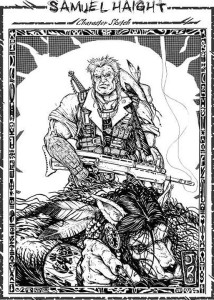 This is another panel I recorded at Comicpalooza this year, featuring Dave Martin from the Wrecking Crew, Ross Watson, and Lenny Balsera from Evil Hat. They talk about designing memorable and effective villains for your game. Enjoy!
This is another panel I recorded at Comicpalooza this year, featuring Dave Martin from the Wrecking Crew, Ross Watson, and Lenny Balsera from Evil Hat. They talk about designing memorable and effective villains for your game. Enjoy!
Podcast: Play in new window | Download (Duration: 52:04 — 35.9MB)
Subscribe: RSS
If you enjoyed this post, make sure you subscribe to my RSS feed!


Thanks, Ross!
There’s some good ideas here, for sure. One thing they didn’t touch on, though, that I think is very important, is the difference between a villain and a monster. A villain is a person, who has some sort of plan that puts them at odds with the protagonists. Generally speaking, it is an active, decision-making person.
A monster, on the other hand, is less of a person than a thing. It doesn’t have plans, it just has actions. It’s more like an animal than a person. For example, the xenomorph from Alien is a monster, not a villain.
In short, a villain is dangerous because of his goal and what he does in order to accomplish it. A monster is dangerous because of what it is, and what it does to express its being.
Because of this big difference, one of the fundamental decisions to make when you’re constructing a story or RPG scenario is deciding whether you want the players’ enemy to be a monster or a villain. Different story types will call for different answers to that question.
The Xenomorphs arn’t Villains, they are monsters.
Fun panel, but I agree that the panelists needed to make a distinction between “villains” and “beasts/monsters/nature/etc..”
But I am glad they spoke at least a little about the difference between antagonist and villain. My main criteria for villains is that they have convictions that cannot be broken, and they will die/do whatever necessary to uphold those convictions. For this reason, they are often kinda boring, so I typically only use a true villain in a one-shot or “light” or comedic game. For longer campaigns, the villains might start as villains, but they almost always slide into the role of antagonist, and allow their agenda to change based on player actions .
For example, Mr. Freeze might start out wanting to do whatever he can to unfreeze his wife, but as Batman and Robin keep dicking him around, his agenda changes to eliminate them as a threat, and he teams with Poision Ivy because she has similar goals. Would he still want to unfreeze his wife if becomes attracted to Posion Ivy and at least forms a platonic bond with her? Have his new feelings compromised his original convictions? And do Batman and Robin really want to take him out if he holds potential clues to stopping Poison Ivy’s crazy pollen she plans to wipe out the city with? Does Mr. Freeze want the ENTIRE city to suffer, or just those who have wronged him? And so on and so forth until Robin dies again and Batman becomes the motherfucking batman
“Secret twin brother of David Bowie” highlight of the entire show.
Great panel & agreed about finding ways of sending messages from the main villain to the players (though messages or lackeys) to keep that menace in mind but you can’t get him/her/it. Also love the idea of putting in more reasoning behind the villain for the players when they kill him/her/it not only why they were a jerk to the players but how the villain made the choices that the players wouldn’t to keep XX from happening. And now with the villain dead, the players just opened Pandora’s box with a single strike.
Always strive to give the villain motives, write down tips on how they might react to things & put together a backup plan so when the villain dies, someone in the group or a rival group will take over to fill that void in power.
Yeah the villain is a jerk but to his/her/it’s perspective, they are the hero of their own story with the players being the antagonists.
SAM HAIGHT. I still think you should make Caleb read about him for After Hours. vampire manther’s got nothin on Sammy.